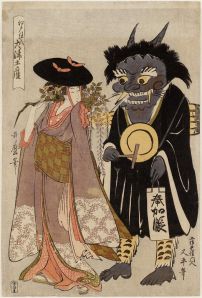Introduction
I have been fortunate enough to have my friends visit me in Japan frequently even after 2 years since my (temporary) leave from school in the North America. I love showing them around the cities I love and taking them to the restaurants for the food I crave, but I have not been recording the accounts of my travels with them in writing, which would have helped a lot for me to concretely learn about the places I have taken them to as well as to explain to the visitors why I take them to these places that are canonical in various guidebooks. It would not be sufficient for me to offer myself as a guide if I am taking them to places any guidebooks can simply tell them. In order for me to fulfill the honour which my friends have bestowed upon me, I need to show them the cities in the way I love about them – I need to have a personality, as it were, in my recommendations that are unique to my perceptions about those places. While I have been very satisfied with the places I have taken them to, I have been unsuccessful in offering them the proper reasoning with which they can satisfactorily understand why they are being taken to these specific places and not to other places.
I thought it would be a good occasion for me to be aware of the activities and histories implicit in appreciating the places I have taken them to so frequently. My hope is that this travelogue would serve as a clearer guidance as to why visitors should visit these places rather than any other place, and further, I hope to hear from my readers any suggestions or comments on my reasoning to better improve my sightseeing itinerary. On that note, let me begin with the most recent pleasure I had of showing my friends around the city of Kyoto.
Chapter 1: NijōCastle, Eikandō Zenrinji, and Heian Jingū
A friend of mine from school and her family in Montreal came to Japan on vacation, and I was honoured to be asked to be their guide while they stay in Kyoto. Even though I am not an expert in Japanese history, I dabble it a little, and I am an aspiring academic whose area of focus primarily includes the history of ideas in Early Modern Europe and in Japan. Being originally from Osaka, I have often travelled to Kyoto since I was little and have visited numerous temples and shrines with my family and form schools ever since. My specific interest in medicine in the 16thand the 17thcenturies has also made me appreciate more about the history before Edo-period, and I am always excited to talk about the history as well as the cultures in a given local setting.
Our first day in Kyoto turned out to be a rainy day. We had initially planned to start with Kinkaku-ji (Golden Temple; see Chapter 2 for detail), followed by a lunch and Ginkaku-ji (Silver Temple; see Chap.2), ending with Kiyomizu Temple (see Chap.2), but fearing that walking in those areas can be undesirable on a rainy day, I decided to change the plan and switched around the places we were supposed to visit on the following days to fit the weather constriction. There are of course many temples which you can safely spend time at without worrying about getting wet in Kyoto, however, this is a Kyoto trip for someone who visits Kyoto for the first time that I am planning, and not a day trip plan for someone who can afford to come to the city whenever they feel like it. So, it must fulfill the following requirements: 1) the places they visit must have some degree of historical significance that is internationallyrecognized, i.e. must have an International Appeal, 2) the places must be somewhat thematically organized so the histories or cultures about those places can be more easily retained in memory, i.e., memorability, 3) each place to be visited must have a uniqueness of its own so as not to be confused in memory later with all the other places they have visited, i.e. distinctness from each other while being thematically similar, and 4) the local and regional food or activities must be included, i.e. cultural appreciation.
In sum, places to be visited must be internationally famous so that even if they did not enjoy the places, they can still say that they have beentoKyoto with authority and that they can have their own opinions about them. This requirement satisfies the purely formal criterion of “having been there” aspect. The thematic organization and distinct categorization each avoids geographical/spatial separation and temporal conflation. By that, I mean if the places visited on a day is thematically organized, no matter far away they are from one another, they will always be remembered by association as a set, and one idea of any one of these places visited will necessarily trigger the other memory that is associated with it. Furthermore, if the places to be visited are chronologically connected or express a certain period in time rather than a whole range of periods at random, again, the idea of one period will necessitate in their mind to think of the following or preceding era(s) because they have experienced them by going to those places in a temporal order. These will encourage curiosity in them to learn more about the period(s) and the places and appreciate them more qualitativelyas opposed to the mere quantitativeappreciation satisfied in the International appeal. Lastly but not least, food and cultural activities that are parochial need to be included so they are not only learning about the new places and enjoying the tour intellectually but also empirically.
So, my tour plan must include both the quantitative-qualitative aspect and the intellectual/rational-empirical aspect in order for it to have a fully satisfying experience for any visitors. But that would only be said to be a full experience in an internal and subjective manner, i.e. the visitors can have those experiences without having me as a guide as long as they have a well-planned itinerary. Hence, I need one more criterion for justifying why it is better to have meas a guide rather than travelling by themselves or with someone else as a guide. That is to say, I as a guide must exhibit an emic perspective that is unique to who I am. The interactions with the locals or the ones who have studied about the area exclusively would add much more insight and meaning to the travel experience and make it unique to their own. With that in mind, I eventually settled on visiting Nijō-Castle[1],Eikandō Zenrintemple[2]and Heian-Jingū[3]on this rainy day. Now, on the surface, these three places have nothing in common, as Nijō-Castle was built for Tokugawa family’s residence during the Edo-period while Eikandōwas established during the Heian-period. As for Heian-Jingū, it was only built in 1895 to replicate the Heian period as a commemoration for its 110thyear anniversary of the establishment of Heian-kyō, over twenty years after the Edo-period ended! What I focused on here, then, was not the historical connections with each place but on the various types of landscapes and gardens from Japanese history. The architecture of the main palace at Heian Jingū, for instance, mirrors the design and features of the Kyoto Imperial Palace in the late Heian Period (11th-12thcentury). The Japanese garden at Eikandō-Zenrinjiexpresses the solemn beauty that is a characteristic of the Muromachi period landscape. Nijō-Castle came in a much later period, yet its garden makes its use of space so abundantly that the sheer magnitude of the entire premise is sure to overwhelm any visitors with awe. Nijō-Castle, however, has another significant role to play in the visiting of Kyoto. In fact, Nijō-Castle marked both the beginning and the end of Edo-period. While it is true that the capital moved to Edo (the present-day Tokyo) in Edo period, the emperors still resided in Kyoto and the Shoguns needed to pay occasional visits to them throughout the era. The castle was used for the Shoguns’ lodging when they visited the old city until the restoration of power to the emperor that promoted Meiji period in 1868. Hence, Nijō-Castle is a product of Kyoto and is not at the same time in the sense that it is of the oldperiod. Indeed, the other places most frequently visited in Kyoto were from the period when Kyoto was still the capital of Japan. Its unique status in a historical standing as well as its historical value set itself apart from the rest of the establishment, I think, and that is the reason for my putting Nijō-Castle into the category of ‘landscape’ viewing itinerary, as opposed to, say, a ‘temple visiting’ itinerary. It seemed also fitting to start the tour of Kyoto from the grandiose Edo-period Shogun’s residence that marked the beginning of a new era both to grovel the visitors before the power of Shogun and to make an opening, so to speak, into the belly of the history of Japan. There were a few other advantages in choosing Nijō-Castle as the starting point and not visit there on the same day as we would visit Kinkakuji and Kiyomizu-temple. Even though it was a residence, it was at the same time a place of formal reception. As such, it was built in the center of the city, close to the Imperial Palace. However, all the majortemples in Kyoto are located at the outskirts of the city, and it is rather difficult to include Nijō-Castle if we plan to visit three temples in one day. There are few places that could be visited in the central Kyoto, however, including the Imperial Palace and Heian-Jingū amongst the others, which are also difficult to fit into a multiple temple visiting itinerary. On top of that, it was a raining day after all, and the castle provided us with a shelter for a short period. If it was raining heavily, neither Nijō-Castle nor Heian-Jingū would have been a very good choice. However, a little rain would enhance, rather than detriment, the expression of beauty in the gardens full of greenery, I reasoned. So here we were, starting with Nijō-Castle to mark our first activity in Kyoto.
After walking in and around the castle, we would see a rather stereo-typical Japanese garden that one may see in a botanical garden of the Japanese garden section in the West. It is rather a long walk in the garden when it is raining after the initial viewing of the castle. Such a walk is made exciting during the spring light-up of the castle and the garden, however, the light-up event had already been over by the days we got to Kyoto. The time allocated to the viewing of the castle and walking in the garden was about 90 minutes – I normally try to make it before 10 am so I would have enough time to find a restaurant for lunch and begin the next spot on the list flawlessly. It is always challenging to find a good restaurant that can be a representative of a Kyoto-experience. What are the famous food in Kyoto? The first few things that come to my mind are vegetables, tofu-skin (yuba), soba, udon noodles and sweets with macha or dango and so on. These are only a very few of the candidates representing the Kyoto food culture.[4]Generally speaking, dish with vegetables and/or fish are traditionally relatively predominant in Kyoto. Kyoto may also be a city where it is easier for vegetarians to find food that offers a traditional experience rather than having to choose to have a bowl of salad. Kyoto is, however, very much conscious of its culinary style and dashi stock (or, bouillon) is often an essential ingredient in Kyoto dish. This could be problematic for vegans or vegetarians who do not consume fish, for dashi stocks are oftentimes made from fish. There are of course vegetable dashi-stock, but it may generally be difficult to find a restaurant that does not use fish-based dashi not just in Kyoto but in all over Japan. My friends in this trip were not vegetarians, though they preferred vegetables to fish or meat. Kyoto, luckily, offers a very wide range of traditional food in that respect. So we went to this restaurant called Okakita[5]that has served various udon noodles and rice bowls for the last 70 years. It is located right next to Heian-Jingū and thus is in the center of the city.

After lunch, we headed towards our next destination, Eikandō-Zenrinji, which was about a 30 minute-walk from the restaurant to the east. By then, it was already past 1 pm. Each temple/shrine visit would necessarily take about 90 minutes, and I had initially planned to go to Heian-Jingū since it was right next to the restaurant, only to find out that Heian-Jungū would be open until much later and Eikandō-Zenrinji would close almost 2 hours before the former would close. Quickly changing the plan, we hurried to Eikandō-Zenrinji, which was first built in 853 as a Shingonsect temple to worship Five Wisdom Buddhas, but shifted its style to Jōdosect, formally introduced to Japan in 1175. Eikan 永観 (or also pronounced as Yōkan), who was the seventh head monk at the temple since its establishment in 853, built a facility used to give the needy and care for the ill. It was during Eikan’stime that the temple gained prestige so much so that there is a rather unflattering story of Eikanrecorded in document that is still told to this day. According to the story, Eikanalong with a number of monks was reciting sutras, when the statue of Amidacame to life which halted the ritual. AmidaBuddha then looked back at Eikanand told him, “You are too slow”. Ever since then, the posture of the statue has remained in that position. This statue of Amidais securely stored at the Amida-Hall.[6]
This temple is also known for its autumn foliage. It is much visited by many during November into early December, but it is surprisingly quiet during the spring to early summer season. The orange coloured Japanese maple leaves (Momiji) are mesmerizingly beautiful, but the green and new Momijileaves too are quite beautiful as well.
The next and the final stop was Heian-Jingū. By the time we got to the shrine was, I believe past 4 o’clock. Luckily, we still had about 2 hours to see the garden. As has been stated earlier, this shrine was built to replicate what it would have looked like during Heian-period for its 1100th anniversary of the city’s establishment during the Meiji period for the industrial exposition fair held in Kyoto in 1895. Heian-period began in 794 and is named after the city of Heian (meaning ‘long lasting peace’), which formally ended in 1192 at the beginning of Kamakura period (initiating the rule by warriors in the subsequent centuries). It was the time of peace, as the name prophesied, and many art forms were cultivated and encouraged during this time. The Tale of Genjitoo is a product of this period. As a replica of such period, Heian-Jingū hosts many aspects of ‘good-old’ Kyoto. Its garden is probably most spectacular feature, as it takes up over the half of the area. The water in the ponds comes from Lake Biwa, the largest lake in Japan, in nearby Shiga-prefecture, and rare species of fish and turtles are seen here.[7]Although it was for an exhibition, the building remained to commemorate the emperor Kanmu, who was the emperor when Heian-kyō[8]became a capital.
By the time it was closing, there were almost no people left at the garden, which gave us a private viewing of the place with only the sound of a drizzle onto the pond to be heard. In this way, we ended our first day in Kyoto after 8 hours of walking.
Chapter 2: Kinkakujitemple, Ginkakujitemple, Kōdaijitemple,
Entoku-Inand Kiyomizu-dera
The second day onwards was a sunny day in Kyoto – a perfect weather for walking around the city and visiting temples. As it was just after the rain, the temperature was just right. We continued our trip with the initial itinerary plan for the first day, which ended up a much longer day than we had anticipated.
When I take people around in Kyoto, if they only have one-day there, I always follow this route to experience Kyoto. Kinkakuji – Ginkakuji – Kiyomize Temple is a route that covers the main temples in Kyoto, including the two of the most visited temples, i.e. Kinkakuji and Kiymizu-dera. This not only satisfies my criteria for a quantitative aspect but also a qualitative one as well, since in addition to be able to visit two most famous places in Kyoto, the paths leading towards them are just as what you would expect in Kyoto. Just in terms of popularity and notability, some might put Nijō-Castle in stead of Ginkakuji, but there is a logistic difficulty in such a plan. For if one were to visit the latter three set of places, there may not be enough time left to complete all three. Geographically, it only makes sense to either start with Nijō-Castle and work way up to Kinkakuji and then back to Kiyomizu temple or start with Kiyomizu temple and end with Nijō-Castle since Kinkakuji is located father north of the city and if you want to economize the time, you do not want to end up in the north when the sun begins to set. However, there are way too many distractions and souvenir shops along the path towards Kiyomizu temple that it is not wise to go there in the first thing in the morning, as it is very easy to spend time on the streets and to get tempted to just forget about the rest for the day. The most you could accomplish as tourists if you go to Kiyomizu temple in the morning would be one more place to visit on that day. But if you are only staying in Kyoto for a few days at most, and if you want to see and experience a variety of culture and be exposed to as many historical wonders as possible during your stay, Kiyomizu temple needs to be visited at end of the day. However, as I mentioned above, if you were to visit Nijō-Castle in the morning and then to Kinkakuji temple, and then to Kiyomizu temple, the transportation alone could take up some of the valuable time and I fear there would not be enough time to get to Kiyomizu temple.[9]While I would agree that you could visit all those places in one day, you will be necessarily taking a bus back from Kinkakuji to the downtown Kyoto to get to Kiyomizu temple, which takes away some fundamental experience of walking in the suburban part of the city. For a mere transporting to a place to another is not necessarily better in terms of experience – while such an itinerary may satisfy the quantitative requirement of sightseeing, it would rob away the qualitative aspect of the trip. Riding on the bus in a foreign country is surely an experience, but when you have to do it many times, it is refreshing to take a different means to explore the city. Walking in Kyoto is in itself an experience, but when you are just visiting for a few days, you do not have much time to spend on walking aimlessly in hopes that you may find something interesting. Chances are that you will find something interesting walking in a foreign country, if ‘something interesting’ just means ‘anything new’. However, something new does not necessarily fit into the grand scheme of narratives you are here to explore. It is good if you find something interesting in your trip, but it is even betterif you find something interesting that is grounded in a theme to tell a cohesive story. My itinerary on the second day, then, is organized around achieving that goal.
As usual, I started with Kinkakuji for two reasons. First, it is situated in the further north of the city of Kyoto that, by starting the day early in the far north, it would save time because I start at the northernmost area and gradually move my way back to the center, as opposed to starting at the center and then move northward and then come back. Second, Kinkakuji is ravishingly golden in its appearance that it sets a glorious mood for the day. It is better to start a day with the main and most lively attraction of all than to start it with a relatively minor spot and move upwards on the scale of excitement. Kinkakuji also uses up a lot of energy not because of the largeness of the garden but because of the swarming school students and tourists, constantly clogging your way through. After the customarily photo-op of the golden temple in the background, we walked along the beautifully arranged pathway and arrived at the Macha tea house, where you can have a quiet experience of having a cup of macha tea in a traditional setting. At Nojō-Castle the day before, we saw the political display of power right before us, making us aware of the period of battles and conflicts that once comprehended the entire city of Kyoto. On this day at Kinkakuji, sipping a bowl of macha tea surrounded by the natural gardenic landscape, we cleansed ourselves in the part of the history which embraced the cultural and religious appreciation of nature. With this activity, we end our visit to the golden temple and headed out for lunch and Ginkakuji.
Whenever I follow this route, I always make it a rule to stop at a local udon noodle restaurant called Ómen.[10]However, as luck would have it, it turned out to be closed on that day (Wednesdays). Having arrived at the area right by Ginkakuji, I was suddenly at a loss as to where to eat. This question may not seem as grave as I make it sound to be for many, however, I am an academic foodie and, like writing an essay with premises to support a conclusion, I like to tell a narrative about the places with the restaurants we eat at in order so that I could present a larger picture of the food culture by the end of the trip. This means that not anyrestaurants would do the job. Just as I cannot make an argument that dogs can swim because I had cereal for breakfast to-day, I cannot tell a consistent narrative to make a point about the food culture if a Kyoto themed restaurant had to be replaced with a mediocre Italian restaurant. Again, I am not saying that you cannot find a good Italian restaurant in Kyoto and that you would not have enjoyed the meal anyway, but only that it seems not only a waste but also detrimental to fill your stomach with a premise that does not necessarily support your conclusion.
In this way, we were forced to look for a suitable replacement that aligns well with the theme of the day and the visit. Many of the restaurants there on the street had similar items on the menu, which is fitting for the argument they are trying to advance as well. Indeed, each district should be making an argument in their own environment. This is why we do not see, especially in a smaller district nearby a temple, any European dish or Indian restaurants but they all seem to serve similarly oriented dish that represents that area of the town. This should make things easier, you may think, because if they all have what each other has to offer, it should be obvious that eating at any restaurants would suffice because they are all the same anyway. That is true and false at the same time, however. It is true in the sense that we know what food to focus on, lest so that we would not accidentally get the French-fries or pancakes, but it is false in the sense that we are now presented with many sets of premises for a specific conclusion we want to advance. As I have said above, each restaurant and each food we eat along the way until the very end of the trip builds up a likelihood of the conclusion in an inductive way. If we are presented with the similarly themed premises for a specific conclusion that needs to be reached at by the end, due to the limitation of how much we can eat in a day, using up one meal out of three on a wrong dish would leave us farther away from reaching that conclusion. At its worst, we may be entrenched with dealing away with the weakpremises, if not wrong, that we may not advance. I had only several minutes to decide in the entire street of restaurants leading up to Ginkakuji. Which restaurant would be best substituted for the one we had set out to eat at? There was no right answer (though there seemed to be many wrong ones), but we opted out for what seemed to offer a different narrative that best suited for our purpose of the trip. We went to the one that served udon noodles and grilled onigiri rice balls. That worked quite well, since grilled rice balls are something that the Japanese are casually fond of but it is hard to get when travelling – no convenience stores would have a freshly grilled onigiri nor restaurants usually carry that item on the menu. Furthermore, this restaurant, the name of which I cannot recollect now, had a yuba-dōfu udon noodle (i.e. udon with tofu-skin), which is among many things what Kyoto is known for.[11]This also helped us set a leitmotif in our food experiences in Kyoto, as we had udon noodle with thick starchy sauce the day before and then another type of udon dish unique to Kyoto on this day. If we could go to the udon restaurant I had initially planned to go the next day, we could theme our lunch with variations of udon noodles that are all unique and express the city of Kyoto. The grilled rice bowls too had played a significant role in expressing the sentiment of Kyoto, as it was grilled with soy sauce and white miso, which Kyoto is also known for.
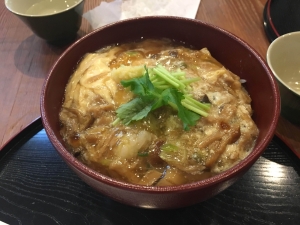
Having enjoyed our supporting premise, i.e. meal, we resumed our itinerary into Ginkakuji. This is often translated into English as Silver Pavilion/Temple, as opposed Golden Pavilion/Temple of Kinkakuji, and was built somewhat in competition with the latter, for the purpose of building such a ravishingly golden Kinkakuji was to display the political authority (taxing the people to pay for the gold). So it was with Ginkakuji, though the temple does not actually use any silver at all.[12]Instead, it is a stereotypical wooden structure that is characteristic of Muromachi period. Many tourists tend to just go to Kinkakuji, as it is internationally more famous for its flashiness. However, those who actually have visited both places would often prefer Ginkakuji (Silver Pavilion) to Kinkakuji (Golden Pavilion), as the former displays a more nuanced spiritual calmness compared to the latter. It is also located at the polar opposite side in the northeast of the city from where Kinkakuji is located, which is in the northwest of the city, and both thematically and geographically, it makes sense to visit both places on the same day to cover the outskirts of the city. Another reason for choosing this place as the second spot in the itinerary is that it gives us a smooth transition to Kiyomize-dera, for there is a path starting from Ginkakuji that continues down south to the center of the city that you can walk called The Philosopher’s Path, so -called for a Japanese Hegelian philosopher and a professor at Kyoto University during the early 20thcentury would often promenade by the river canal that runs through the city.[13]The path is also a great walk during the cherry blossom season and in the autumn. It starts from Ginkakuji to Eikandō-Zenrinji and into Nanzenji temple and Chión-In temple towards Kiyomizu-dera district. It is a good 40-minute walk from Ginkakuji, and normally by the time we get to Kiyomizu-dera area, also known as Higashiyama district, it is about 4 pm and plenty time to see the temple and browse souvenir shops in the area. As I said earlier, it is best to have some spare time planned ahead for this part of the city, as this is where most souvenir shops are located and many things Kyoto are definitely found here. However, one thing to note is that the shops around here (or around temples, unless they are in the downtown Kyoto) close at 5:30 to 6 pm, within the hour the temple closes. So if you arrive at Kiyomizu area at 4 pm, allocating 60 to 90-minute to the temple area would leave you only an hour or less to shop around. This would usually be enough, as long as you have extra hours at the end of your visit to Kyoto to come back for a souvenir shopping. This first visit is spent usually on promenading through the shops and decide what you may want to come back to buy for later. That was the plan, but yet another unexpected event was inserted. We did arrive at around just before 4 pm at the area yet continuing with the theme of Japanese gardens and knowing that my friends would enjoy seeing more of the traditional gardens, I made a judgment call to stop by at Kōdaiji temple (which is coupled with Entoku-In right across the street). Kōdaiji temple is located in the midst of the Higashiyama district and is a temple where Hideyoshi’s wife, Néné, dedicated her remaining life as a priestess after her husband’s death.[14]This temple and its garden represent a Zen philosophy and the landscaping was designed by a well-known aristocrat and a landscape gardener, Kobori Enshū, and completed in 1606.
The decision to stop by at Kōdaiji was good but also a tricky one, since visiting here would make us available at only around 5:30 to go to Kiyomizu temple just in time for its close at 6 pm. This would mean that there is no time left for the souvenir browsing, which was worrisome. However, we somehow managed to get out of the temple by 5:15 and then to browse around the shops walking up the streets and made it in time to get into Kiyomizu dera before 6 pm. It was already known to us that the said temple was under renovation and the most of the main hall was covered with sheets. It was for this reason that I suspected we would not need a lot of time to spend at this temple but it was enough to merely fill the quantitative requirement for this temple at this time. It was really serene and beautiful there, even though the most of it was covered. There were so few people, where it is otherwise overcrowded with tourists. It was not owning to the renovation that was undergoing, however, but it was because we got in 10 minutes before the closing time. It seemed like we were the only ones there and although it was rushed a little bit, it was very aesthetic and pleasing to walk in the quiet temple garden.
We were not out of the temple and ending our second day – yet we had more things to do on that day. The shops were still semi-open and we could go into several of them including my one and only favourite incense store on Ninen-zaka street called Niimi.[15]This is where I always make sure to get incense whenever I visit Kyoto and I have even had them ship incense to Canada in the past decade. It is that good. I was told by the manager at the store then that there is going to be a second branch opening in the midst of Gion street on Hanami-kōji[16]in July of 2018. It would be an amazing store to have in the center of Kyoto.
We then went to the other one and only Starbucks whose building is tailored to the local culture – that is, this Starbucks uses the Japanese traditional old housing of Kyoto and has seats with tatami mattresses inside.[17]
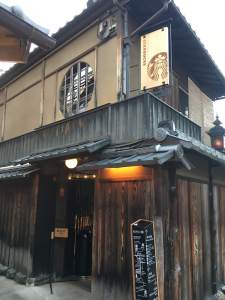
Having emerged ourselves with the richness of Kyoto culture, we were now headed for the dinner. Again, my travel plan is asset of arguments with each activity supporting its intended conclusion. However, I purposefully deviated from the underlining theme of Kyoto for dinner plans. This was because I could only get to see my friends during their visit in Kyoto and Osaka, and while there are many Kyoto specific dish to advance, there were also other aspects of Japanese food that I wanted to demonstrate to them. Therefore, I themed lunch and snacks in a Kyoto style fashion, but I advanced an argument for Japanese food culture in general in the evening. I only had a few days with them, and as such I had to make choices. While there are varieties of Japanese food that is authentic and traditional, such as sushi and tempura, etc… those items are easily acquired with good quality in the West as well. I wanted them to taste something they could only taste in Japan and limited to the food category in mostly chicken and vegetables which they enjoyed, but that did not narrow down much yet either. This is where the locals could be useful in offering an emic perspective that the tourists could otherwise not have been able to experience had they come all by themselves. There is simply way too much variety in food in Japan that one is often at a loss as to where and what to eat. In fact, food culture in Kyoto-Osaka area (as well as other parts of Japan) is such that you cannot probably try all the restaurants in a life time. Faced with many premises, I needed to be conscious of the kind of argument I wanted to make, which was for dinner to introduce them to Japanese dining experience. It does not have to be a fancy, expensive restaurant experience but it could also be a very local, family-oriented chain restaurant that the locals would frequent. Since I could only choose a few dishes out of so many that I could show to them, by the process of elimination, I could take out the Japanese food that is often offered overseas and whose quality is quite well-preserved outside Japan. Sushi restaurants and tempura restaurants as well as some of the common food such as rice bowls and fish can be enjoyed in Canada as well with just as good a quality as they are in Japan, thanks to many Japanese chefs opening restaurants over there. I asked myself what I had missed the most in 10 years of living abroad. What were the food that is both difficult to recreate at home and impossible to find at restaurants overseas? And such food must be primarily chicken or vegetables for this occasion. The first thing it came to my mind was yakitori. For some reason, I have never had a good yakitori in Canada or in the States that can be properly called ‘yakitori.’ The chicken tends to be cooked more thoroughly in the North America and probably they use a different breed of chicken as well, as in Japan, we do occasionally eat chicken sashimi– raw chicken, the idea of which is abhorred by foreigners. Oftentimes when I mention to my friends in overseas, they would tell me that it is not safe to eat chicken raw. However, that is not really accurate. It is accurate in the sense that beef tartar or even raw squid is not safe to eat. Chicken needs to be raised in a specific way for a raw consumption and must be disinfected thoroughly, but it is not contradictory in its definition to be prepared raw, as experience shows. It is a particular delicacy in southern part of Japan for a long time, and one can get safe raw chicken at various restaurants. In any case, it is nonetheless a rather high bar for those who are not accustomed to eating raw meat to try. But I would recommend it if any of the willing readers ever visit Japan, because it is really good.
Going back to the dinner, because of the reasons I raised above, chicken meat often has a different texture in Japan from in the North America. Even at Japanese restaurants run by Japanese chefs could not replicate yakitori served in Japan. So the first thing I wanted to try when getting back to Japan was to eat yakitori. With this passion in mind, I decided that we would have yakitori grilled chicken skewers as a sampler of Japanese local cuisine. One problem with many of the yakitori restaurants in Japan is that they are often smoking-allowed inside the store, probably due to the Izakaya culture in which customers would often smoke and drink after work. Even though many restaurants have followed the suit of the European countries in banning smoking inside the restaurants, some Izakaya places still operate under the old tradition. Yakitori is one of the soul food for workers in Japan that smoking while eating and drinking still remains deeply rooted. We wanted to avoid smoking-allowed restaurants, so our options were rather limited. The one yakitori place I really like is a chain restaurant called Daikichi, but its customers are usually smokers. So I ventured into a yakitori restaurant that is local and unknown to me. The dinner there was great – yakitori, to be honest could have been better, but the miso glazed eggplants and umeshu, i.e. plum wine, were supremely divine.
Thus, we concluded our second day, and we would rest well for the last day in Kyoto together.[18]
Chapter 3: Arashiyama and TenryūjiTemple in Kimono
Our last day together in Kyoto meant it is also a time to make a concluding remark in my argument. Some people may think that it is inconceivable that we did not visit Fushimi-Inari or Byōdō-In temple, to which I would agree with them. However, I did not include that in my 3-day visit itinerary in Kyoto with them because they were going to visit those two places the following day with another friend of theirs. So I decided that the only other places that need to be visited in Kyoto on the first trip are Arashiyama and Tenryūji, surrounded by a deep bamboo grove. Instead of simply visiting there, my friend suggested we would wear kimono and walk around. That was such a brilliant idea that we planned the day accordingly. We also had planned to attend a tea ceremony in Higashiyama district near Kiyomizu temple later in the afternoon. This worked out well since, even though it would be far away from Arashiyama to the center of the city, we still had not yet a proper time to shop around the souvenirs. The appointment at the tea ceremony set us the time limit in Arashiyama and that made it easier to plan the morning plan accordingly. We began our day, as per usual, early in the morning so that we would get to our first destination at the earliest time possible. Since we planned to wear a kimono and walk through the bamboo forest, we got to the kimono rental place at around 9:30 am. We changed into kimono and began walking slowly, as the footwears did not allow us to walk fast. We arrived at the bamboo forest at around 11:30 am, and spent some time taking pictures in costume. We then arrived at Tenryūji temple[19]where I also made a reservation for a traditional temple dish, Shōjin Ryōri.[20]
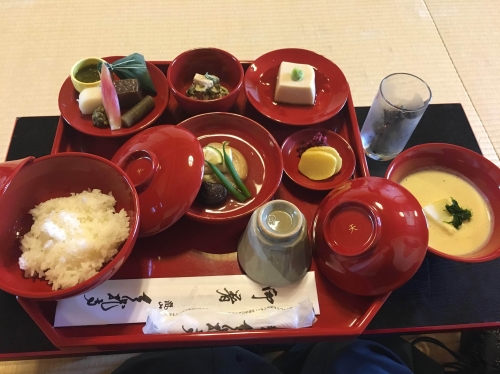
The lunch was amazing and it was very filling as well. Especially sitting on the tatami room in a traditional resto-house with kimono in Kyoto was something exquisite and enriching. Shōjin Ryōri is also something that encompasses the culture of Kyoto that it was better appreciated after having been to all the places we went and having tried all the food we tried. It was in essea summation of Kyoto trip, a finale to be impressed upon memory. After the lunch, we hurried our way back to the kimono rental place to return the kimono (as we were all getting quite uncomfortable with the shoes) and changed into our own clothes and resumed our walk into Togetsu-kyō bridge. Along the way, we stopped for macha drinks and rest at Arashiyama station. We had to leave the place to catch the train at 3 pm, so we walked rather hastily across Togetsu-kyōbridge and got to the station. We then got back to Shijō area, the center of Kyoto to walk up to Kiyomizu area. We went through Yasaka shrine and arrived just in time for the tea ceremony at Ninenzaka street where we were to have the experience. It took about an hour, learning a little about how to drink tea properly and then we had exhausted all the activities that were time-sensitive. We then looked around the souvenir stores and visited Ghibli store and other cute shops. It was time to go back for the last dinner in Kyoto together, and we strode through Hanami-Koji and were lucky to see a real Geisha passing by us. The concluding paragraph for the Kyoto visit naturally consummated in the udon restaurant that we had planned to go earlier. Ómen, the restaurant, is a chain restaurant in Kyoto and there is a branch in the downtown as well. This udon is uniquely Japanese in that you dip the noodles into soup and eat, rather than the udon already soaked in soup. You also put vegetables of your choice and spices to taste. With this dish, we completed the 3-day plan of visiting Kyoto.
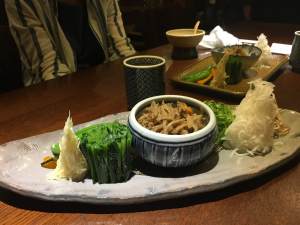
Conclusion: The Itinerary Revisited
In this way, our all day long activities of experiencing Kyoto in terms of history, society and culture was concluded. We had to make several in-the-moment choices due to the bad weather and unexpected events, which are a part of what it is to travel, but it was overall a complete success. In this itinerary, I divided the activities into 3 distinct categories according to the themes; namely,
DAY 1: Nijō-Castle => Eikandō-Zenrinji => Heian-Jingū shrine,
DAY 2: Kinkakuji => Ginkakuji => Kōdaiji => Entoku-In => Kiyomizu-dera
DAY 3: Arashiyama => Bamboo-Grove=Tenryūji temple.
These 3-day activities, where each day stands on its own, can be rearranged according to the purpose and preference of the individual tourist. However, I would argue that my plan for each day beautifully illustrates the themes allocated to its respective day in order to successfully reach its own conclusion of the day, which in turn supports a further argument that Kyoto culture is experienced only thorough the aggregates of monadic experiences. Only when these perceptions and sentiments felt have intertwined with one another can a theme of the historical harmony come to life. In other words, each single day filled with the activities by themselves would only express one aspect of Kyoto and it is necessary, for instance, to have experienced previously various types of udon noodles and Japanese food to appreciate the summation of udon at Ómen or Shōjin Ryōri at Tenryūji temple in Arashiyama. Similarly, it was necessary to have been to Nijō-Castle and Kinkakuji temple as well as other temples visited to reach an enlightenment at Tenryūjitemple, whose name means a dragon in the heavens. It is only at this stage in the third day after the series of activities that one finds home at the spiritual awakening in the bamboo forest, dreaming of becoming one with the drago
[4]There are of course Kaiseki Ryōri, Shōjin Ryōri, Yu-Dōfuand many other Dashi-based dish that are distinctly Kyoto. Nishin(herring) sobaand tempuraare also locally known. Sushi also was first inventedin Kyoto, i.e. nare-zushi. Ayu(or sweetfish) too is a delicacy.
[5]See https://www.yelp.com/biz/岡北-京都市for reviews and see http://www.kyoto-okakita.comfor the official website (only in Japanese).
[6]https://en.wikipedia.org/wiki/Eikan-dō_Zenrin-ji
[7]Namely, striped bittering, https://en.wikipedia.org/wiki/Striped_bitterlingyellow pond turtles https://en.wikipedia.org/wiki/Yellow_pond_turtleand Japanese pond turtles https://en.wikipedia.org/wiki/Japanese_pond_turtle.
[8]Heian-kyōjust means ‘the capital of peace’, as ‘kyō’signifies a place where the emperor resides. So it was with Kyōto, which simply means ‘the city in which the emperor resides’- similarly, Tokyōjust means ‘the eastern place where the emperor resides’ – this is because after Edo period, the emperor moved to Edo, changing the place name to ‘a city in the east where the emperor lives’, i.e. Tokyō.
[9]This could be contested, however, since normally if you start with Nijō-Castle at 10 am, you are most likely to get out and have lunch by 1 pm. You may begin your visit to Kinkakujifrom 1:30 and then leave there at 3 pm, which would give you enough time to not only get to Kiyomizutemple but also have time to shop around. However, I believe this way of visiting each area would necessarily omit the pathways in the city of Kyoto that may be of an equal value to visiting those places, as I explain above.
[10]See here for the reviews in English https://www.insidekyoto.com/omen-restaurant-kyotoand here for the official website http://www.omen.co.jp
[11]https://en.wikipedia.org/wiki/Tofu_skin
[12]There are some theories as to why it is called Silver Pavilion, and one of which suggests that it used to be initially coated with silver but after the multiple destructions of the temple over the years, it was aborted in rebuilding the temple for the expense.https://en.wikipedia.org/wiki/Ginkaku-ji
[13]https://www.japan-guide.com/e/e3906.htmlsee also https://en.wikipedia.org/wiki/Philosopher%27s_Walk
[14]https://www.japan-guide.com/e/e3927.htmland https://www.kodaiji.com/e_index.htmlfor its official website in English. In Japanese, here http://www.kodaiji.com/index.html
[15]For an amazing selection of original and traditional incense, visit here! http://www.2nenzaka.ne.jp/EN/article/11
[16]https://www.tripadvisor.com/Attraction_Review-g298564-d1956593-Reviews-Hanamikoji_Street-Kyoto_Kyoto_Prefecture_Kinki.html
[17]http://www.spoon-tamago.com/2017/06/22/tatami-style-starbucks-ninenzaka-kyoto/
[18]My friends would stay 3 more days in Kyoto, but I was only available for the first 3 days.
[19]http://www.tenryuji.com/en/
[20]https://savorjapan.com/contents/more-to-savor/shojin-ryori-japans-sophisticated-buddhist-cuisine/































